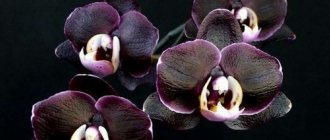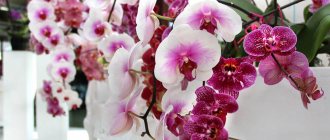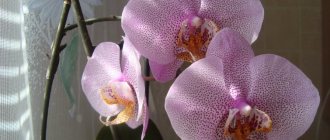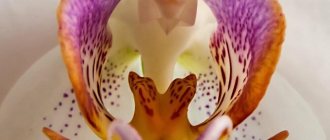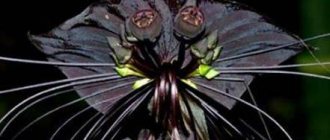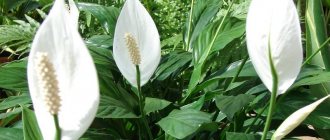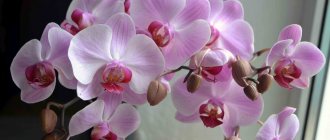External characteristics
The trunk is small, dwarf, grows up to 50 cm, it is dense and hard. The leaves have a scattering of white spots on the surface.
The flowers are small, about 4-5 cm in diameter. Petals are blue or with a lilac tint. The lip is a brighter, dark purple. The number of buds on the peduncle increases with age - they lean tightly against each other.
It is worth noting that the Sapphire variety is a phalaenopsis. In turn, Tzu Chiang is a clan name. It has many other varieties including the white (Chrisna) Krishna and the pinkish Balm.
Description of the Sapphire orchid species
This variety quickly fell in love with flower growers due to its ease of care and exotic appearance, which is why several subspecies of this flower have now been bred. The most popular among phalaenopsis connoisseurs are:
- Vivien Sogo. This subspecies differs from its predecessor in the soft purple shade of the petals and a more intense lip color. The flower is also characterized by the presence of many small flowers on a peduncle. They seem to stick around the entire stem. It blooms for quite a long time, several times a year. It is unpretentious in care, but loves daily spraying from a spray bottle and the presence of moss in the pot.
Vivien Sogo
- Santos. A subspecies of Sapphire, which looks very impressive during flowering. The buds, like all orchids, begin to bloom gradually, quite slowly and retain their appearance and color for a long time. Due to the presence of a large number of flowers, the plant tends to bend, but this condition does not spoil its appearance at all.
Santos
- Fantastic Louise. One of the most luxurious plant subspecies. Its distinctive feature from all others is the unusual color of the flowers: the base is pastel blue, the inclusions are black. Quite easy to care for. It can grow both in dark places and in the sun. Has excellent ability to adapt.
It will also be interesting: How long does an orchid bloom at home - how does the peduncle appear??
Features of flowering
The orchid blooms twice a year. The duration of this period is about a month. The first flowering coincides with the onset of cold weather, the second should be expected in the spring.
If Sapphire blue does not grow buds for a long time, but is developing well, then it is stimulated.
To do this, phalaenopsis is not watered until the soil dries out, and the air temperature is reduced to 16° - in such conditions the flower is kept for 3 weeks. And then they return to normal agricultural practices.
After flowering, the plant needs special care.
- First of all, cut off the dried flower stalks. The room temperature is reduced to 20-21°, and the humidity is increased to 75%.
- After 3-4 days it will completely go into a dormant state. The temperature is lowered again, this time to 16°.
- Watering frequency is reduced to once every 7-9 days. Use complex fertilizers for orchids.
1.5 months in such conditions will completely restore the plant’s strength.
Features of watering mini-phalaenopsis
Compared to ordinary phalaenopsis, dwarf orchids are more moisture-loving. That is why it is recommended to keep them in a substrate with the addition of moss. However, under no circumstances should the plant be allowed to become over-watered, otherwise the death of the root system is inevitable. Therefore, watering the mini-phalaenopsis Sapphire should be organized in accordance with the following rules:
- Orient the frequency of watering not by time (for example, once a week), but by the condition of the roots. After the roots change color to light gray, you need to wait another 4-5 days and only then water the plant.
- Coordinate watering with air temperature. If the room is cool, the orchid is left dry.
- Coordinate watering with lighting. In winter, when daylight hours are short and it is cloudy outside, orchids are watered less frequently than in summer. But if supplementary lighting with phytolamps is organized, the time of year does not play such a role.
When watering mini-phalaenopsis, you need to find a line at which the plant will not be subjected to long drying, but will not be flooded. In this case, its root system will develop normally, which will affect the overall well-being of the orchid.
Conditions of detention
Phalaenopsis needs certain conditions:
- Daytime temperatures from 20 to 26°; night - from 15 to 17°.
- Air humidity is within 60-70%.
- Good ventilation without drafts and cold wind.
- Illumination is high, at least 10 hours a day. At the same time, the flower does not like direct rays.
- Special soil is needed for orchids. In summer, transplantation into open ground is allowed.
- The pot for planting is not too large. The root system should fit completely into it, leaving a width of 1-2 fingers from the walls.
If the leaves have acquired a rich green color, this is a signal that the plant does not have enough light. With light green, yellow and light shades, it is worth putting it in a more shaded place.
Reproduction methods
The culture is propagated by seeds and shoots. The first method is suitable for experienced gardeners, since it requires a fair amount of accuracy and compliance with more conditions than the second.
Seeds
Phalaenopsis seeds are very small and sensitive to the slightest fluctuations in external conditions. Because of this, it is necessary to sterilize all containers and instruments before work.
In addition, the seeds do not have their own endosperm, which makes it difficult to absorb nutrients from the soil. For this reason, it becomes more difficult to germinate them.
To reproduce using this method you will need:
- Glass flasks or jars.
- Cotton wool.
- 10% solution of bleach or potassium permanganate.
The plant needs a lot of light
You will also need a nutrient solution. Cooking diagram:
- 500 ml of water is brought to a boil.
- Add 8 g of agar-agar and 10 g of glucose and fructose.
- Stir until dissolved over medium heat.
- Boil 500 ml of water in a second saucepan.
- The fire is extinguished, 5 drops of Kornevin, 1.2-1.5 g of nitroammophoska, 1 crushed coal tablet are added.
- Mix everything and cool.
Acidity should be between 4.9-5.2 pH. To reduce it, use potash solution, to increase it, orthophosphoric acid.
Stages of seed germination:
- 30-35 g of nutrient mixture is poured into sterilized containers, sealed with cotton wool and foil, and sterilized again.
- Everything is left for 5-6 days. If mold appears inside, the flask is not used in the future.
- The seeds are treated with a 10% solution of bleach or a weak solution of potassium permanganate.
- Sow in a container with a nutrient mixture.
- Clean in a room with a temperature of 18 to 23 degrees and sufficient lighting for about 13 hours a day.
Sprouts appear over a long period of time. The first ones hatch after 3 weeks, the last ones after 3 months. They are transplanted into a new nutrient solution, where they are grown until they are fully planted in the ground.
Rostcom
You will need:
- Transparent container. A sufficient amount of light will pass through its walls for the proper development of roots.
- Soil for phalaenopsis or natural soil. Florists recommend using the bark of coniferous plants.
The drainage is laid out at the bottom of the container in a layer of at least 5 cm to ensure ventilation. The root system of the seedling is straightened, then covered with substrate and watered. Depth of occurrence is about 6 cm.
For a week they put it in the dark with a flow of air. Then place it on a windowsill or other well-lit place without direct sunlight. Water once every 10 days for 3 months, after which they switch to standard agricultural technology.
You can grow sprouts yourself from seeds or take those that sprout near adult plants.
Reproduction and transplantation of phalaenopsis Sapphire
This exotic plant can be propagated both by seeds and by children. At home, both methods are used with equal effectiveness. Children are usually called small shoots that emanate from the common trunk in the area of the flower arrows. If reproduction is planned, then they should not be cut or torn off immediately upon appearance.
It is necessary to wait until these small shoots take root. Only then should you carefully cut them off the stem with a blade. Sprinkle the cut area with cinnamon. The cut baby must be planted in a pot containing standard soil for orchids. For best growth and rooting, it is recommended to provide the plant with greenhouse conditions for the first six months.
Reproduction of phalaenopsis
This event should be done no more than 2 times a year. When choosing the size of the pot, you should start from the volume of the plant’s root system. The soil substrate should only be purchased ready-made and specifically recommended for the Sapphire variety. The bottom of the pot must be covered with drainage expanded clay. There is no point in compacting the roots, as they should feel fairly free in the pot.
Experienced gardeners advise that when replanting an orchid, do not remove it from the old soil. It is enough to change the pot and add a small amount of nutrient substrate.
It will also be interesting: Pink orchid - caring for a houseplant at home?
Care
Flower growers call improper care the most common mistake. It provokes the appearance of parasites and diseases, which often lead to the death of the plant.
It’s not enough to buy a phalaenopsis; you also need to know how to care for it.
Fertilizers
When feeding the plant, it is necessary to follow the recommendations for applying fertilizers. If there are too many of them, the phalaenopsis will begin to wither, while if there is not enough, it will not fully bloom.
The table shows how to use some fertilizers:
| Term | Type of feeding | Proportions | Submission rules | Action |
| Before flowering | Combi-lux | 10 g per 1 l | Water once every 10 days. | Stimulates the appearance of flowers and generally strengthens plants. |
| In summer | Special fertilizer for orchids | Twice less than indicated on the drug label | Fertilize before watering, about once a week | Ensures normal development, stimulates the appearance of young leaves and shoots. |
Trimming scheme
Pruning of inflorescences is carried out only after they have completely dried. When the arrows dry, they are completely removed, capturing a little living twig. Dried flower stalks are removed, leaving 2 cm from the base of the rosette.
If the root system outgrows the flower, it must be replanted.
Phalaenopsis is pruned when it blooms excessively to give it a rest and gain strength. Some gardeners recommend giving the flower a fasting period, deliberately cutting off the flower stalks every 1-2 years.
Watering
Watering with water at room temperature, standing for 24 hours. A dry and wet period is required.
In the summer, half-hour baths are arranged, no more than once every 2 weeks. To do this, the dried root system is placed under the shower and watered until it turns green. Otherwise, the plant is moistened as the soil dries, at intervals of 2-3 days.
In winter, watering is reduced and carried out every 6-7 days.
Preparing for winter
Sapphire does not have a dormant period, unlike other varieties. On the contrary, the first frost is a signal for the flower to bloom profusely.
To make the plant feel comfortable, it is worth:
- protect it from cold air;
- reduce watering;
- add fertilizer if necessary.
Transfer
An orchid is replanted if: the root system has outgrown the pot and no longer fits in it; or the nutrient substrate has lost its properties or is decomposing. It is not recommended to carry out the procedure more often than once every 3 years.
Stages: the new container and soil are sterilized, drainage is placed at the bottom; extract the root system from the previous hill along with a lump of earth; move the flower to another pot and add soil. At the end, watering is carried out with diluted fertilizer.
Recommendations for agricultural technology
Phalaenopsis Sapphire is propagated in several ways:
- children that grow in the soil from the main stem;
- sockets;
- shoots formed on the inflorescence.
Natural soil is chosen for planting. The ideal option is coniferous bark, which holds the plant well in the container. The pot must be transparent so that the root system receives the right amount of sunlight. A drainage system and high-quality ventilation are installed at the bottom of the pot. This allows the orchid to participate in photosynthesis.
The roots of the seedling are distributed along the entire perimeter of the transparent container and densely sprinkled with the prepared substrate. Planting depth is 5-6 cm. The pot is placed in a dark place for 7-10 days, after which it is placed on a windowsill on the north or east side (in such parts of the house the sun's rays are refracted, not direct). For the first 2-3 months, watering is carried out at intervals of 10 days.
Prevention
Preventing diseases and protecting flowers from pests is extremely simple. First of all, before planting a seedling or seed, the substrate is treated with potassium permanganate or oxyHom. The soil must be specialized for phalaenopsis and orchids.
According to the description of flower growers, more often the plant suffers due to non-compliance with agricultural technology. All diseases and pests appear due to excessive humidity, excessive lighting and insufficient fertilizing. Therefore, for normal development, it is worth following the rules of care.
Diseases and pests of Sapphire orchids
The appearance of various kinds of diseases signals the presence of violations in flower care. The first signs appear, as a rule, on the leaves. The most common pathological conditions of the plant are:
- Burns. They can occur in plants exposed to the sun for a long time. In this situation, you should move the orchid to the north or northwest side.
Burns
- Viral infection. Phalaenopsis Sapphire is very sensitive to viral diseases. There is no cure. However, when the first signs of pathology appear, the leaves must be washed with a large amount of a broad-spectrum antibiotic, dried and coated with a Fungicide.
- Fusarium rotting process. In this case, the plant is covered with a small coating, which is fungal spores. For treatment, the plant is washed with Fundazol solution three times a day.
- Anthracnose. The disease is manifested by the presence of black spots on the leaves of the orchid. The causative agent is a fungus. In this case, the leaves of the flower should be smeared with copper-containing preparations.
Anthracnose
An excellent prevention of any undesirable situation with a flower is the correct adherence to all care tips. If you follow the instructions, there will be no difficulties in growing this type of flower. The main thing is to do everything correctly and systematically.
It will also be interesting: Yellow phalaenopsis orchid - caring for a houseplant at home?
Common mistakes when growing
- Using regular soil instead of soil formulated specifically for phalaenopsis. A different level of acidity and an incorrect ratio of microelements can lead to the death of the plant.
- Pots too small. Lack of space for growth inhibits the development of the root system, which has a detrimental effect on the overall appearance of Sapphire blue.
- Waterlogging or excessive amounts of fertilizer have a bad effect on flowering.
- Growing in a place with drafts or on window sills - the orchid does not like cold air. Or in direct sunlight - this burns the leaves and inhibits their development.
- Removing peduncles that have not dried completely injures the plant and reduces further flowering intensity.
